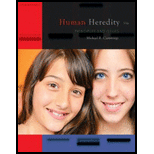
Can DNA profiling identify the source of a sample with absolute certainty? Because any two human genomes differ at about 3 million sites, no two persons (except identical twins) have the same DNA sequence. Unique identification with DNA profiling is therefore possible if enough sites of variation are examined. However, the systems used today examine only a few sites of variation. Nonetheless, even with today’s technology, which uses three to five loci, a match between two DNA patterns can be considered strong evidence that the two samples came from the same source.
DNA profiling in criminal cases has been a useful tool in establishing both guilt and innocence. Originally, DNA databases contained only the profiles of convicted felons. Over time, however, law enforcement agencies have expanded the collection and use of DNA profiles, and these new policies are causing controversies, once again illustrating how the availability and use of genetic technology is often ahead of consensus on how and when this technology should be used. One of these new policies is postarrest DNA collection.
At this writing, 18 U.S. states as well as the federal government allow the collection of DNA samples after an arrest but before conviction. These profiles become part of the state’s DNA database, which is often searched for evidence in cold cases. Courts across the country have ruled for and against the use of such samples.
In 2012, the Maryland Court of Appeals ruled that the collection of DNA samples from someone who has been arrested but not convicted is unconstitutional and violates an individual’s right to be free from unreasonable search and seizure. The case began when a DNA sample was taken from Alonzo Jay King, Jr., who was arrested in 2009 for assault. In a database search, the DNA profile matched that taken from a 2003 unsolved rape. Based on the results of the database search, the man was sentenced to life in prison. The rape conviction was reversed, and the case was sent back to a lower court. As a result, some 16,000 DNA profiles collected postarrest but preconviction since 2009 cannot be used pending appeal of this decision. Before the court decision, postarrest DNA profiles were used in 65 arrests that resulted in 34 convictions, with an additional 12 cases pending.
Supporters of postarrest DNA profiling claim that taking a DNA sample by a cheek swab is noninvasive and no different from taking someone’s fingerprints. Opponents claim that because DNA samples can be used to determine much more than a DNA profile, they are a threat to privacy, and that because minorities are more likely to be arrested, the practice is discriminatory.
Would you object if you were arrested for a minor offense, such as a traffic violation, and ordered to provide a DNA sample?
Want to see the full answer?
Check out a sample textbook solution
Chapter 14 Solutions
Human Heredity: Principles and Issues (MindTap Course List)
- 1. Match each vocabulary term to its best descriptor A. affinity B. efficacy C. inert D. mimic E. how drugs move through body F. how drugs bind Kd Bmax Agonist Antagonist Pharmacokinetics Pharmacodynamicsarrow_forward50 mg dose of a drug is given orally to a patient. The bioavailability of the drug is 0.2. What is the volume of distribution of the drug if the plasma concentration is 1 mg/L? Be sure to provide units.arrow_forwardDetermine Kd and Bmax from the following Scatchard plot. Make sure to include units.arrow_forward
- Choose a catecholamine neurotransmitter and describe/draw the components of the synapse important for its signaling including synthesis, packaging into vesicles, receptors, transporters/degradative enzymes. Describe 2 drugs that can act on this system.arrow_forwardThe following figure is from Caterina et al. The capsaicin receptor: a heat activated ion channel in the pain pathway. Nature, 1997. Black boxes indicate capsaicin, white circles indicate resinferatoxin. a) Which has a higher potency? b) Which is has a higher efficacy? c) What is the approximate Kd of capsaicin in uM? (you can round to the nearest power of 10)arrow_forwardWhat is the rate-limiting-step for serotonin synthesis?arrow_forward
 Human Heredity: Principles and Issues (MindTap Co...BiologyISBN:9781305251052Author:Michael CummingsPublisher:Cengage Learning
Human Heredity: Principles and Issues (MindTap Co...BiologyISBN:9781305251052Author:Michael CummingsPublisher:Cengage Learning Biology Today and Tomorrow without Physiology (Mi...BiologyISBN:9781305117396Author:Cecie Starr, Christine Evers, Lisa StarrPublisher:Cengage Learning
Biology Today and Tomorrow without Physiology (Mi...BiologyISBN:9781305117396Author:Cecie Starr, Christine Evers, Lisa StarrPublisher:Cengage Learning Biology: The Dynamic Science (MindTap Course List)BiologyISBN:9781305389892Author:Peter J. Russell, Paul E. Hertz, Beverly McMillanPublisher:Cengage Learning
Biology: The Dynamic Science (MindTap Course List)BiologyISBN:9781305389892Author:Peter J. Russell, Paul E. Hertz, Beverly McMillanPublisher:Cengage Learning Concepts of BiologyBiologyISBN:9781938168116Author:Samantha Fowler, Rebecca Roush, James WisePublisher:OpenStax College
Concepts of BiologyBiologyISBN:9781938168116Author:Samantha Fowler, Rebecca Roush, James WisePublisher:OpenStax College Principles Of Radiographic Imaging: An Art And A ...Health & NutritionISBN:9781337711067Author:Richard R. Carlton, Arlene M. Adler, Vesna BalacPublisher:Cengage Learning
Principles Of Radiographic Imaging: An Art And A ...Health & NutritionISBN:9781337711067Author:Richard R. Carlton, Arlene M. Adler, Vesna BalacPublisher:Cengage Learning





